Warnings, Labels and Pictogramms on the Scooter
For the safe and proper use of the Seacraft scooter every user is obliged to familiarize himself/herself with the warnings, labels and pictograms placed on the device.
The following is placed on the scooter:
 | Read the instruction before the use! Information on use in the manual! |
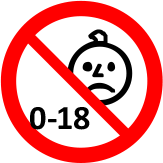 | Use of the item is prohibited by children and adolescents under 18 years of age! Store and operate out of the reach of children! |
 | Important information! / Caution, danger! |
 | Li-ion batteries must be disposed of in accordance with all local and national regulations. If the batteries are not property disposed of, they could pose a risk to human health or the environment. |
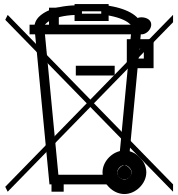 | After the service life, the device must not be placed along with other household waste. Device must be disposed of in accordance with applicable regulations! |
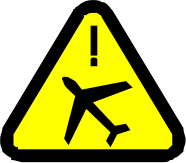 | Caution during air transportation! Observe the restrictions applicable to equipment in air transport! |
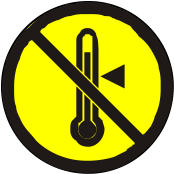 | Do not allow the scooter to overheat! |
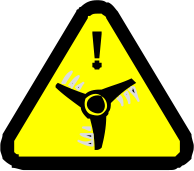 | Caution, fast spinning, dangerous element! Do not insert hands or any other items to the area of the device’s propeller! |
Using the scooter safely
Safe diving with a scooter
Before beginning a dive, you need to do the following:
- Charge the battery to full (→ Charging Procedure).
- Balance the scooter (→ Balance and Trim of the Scooter).
- Make a decision regarding the point of return for your dive according to air consumption, water temperature etc.
- Check, if your regulator needs to be adjusted.
With some regulators, you need to make sure, that the second stage does not give a free flow, when the main membrane is pressed by the raised water pressure caused by the scooter’s speed. To avoid a free flow, the breathing resistance of most second stages can be adjusted. Make sure to adjust both second stages (if present).
During a dive, you need to do the following:
- Control the battery charge level on a regular basis, taking into account the required battery level for the return dive.
- Use the scooter with optimal, medium speed, which allows for longer battery life.
- Control the level of air consumption on a regular basis. Too fast flow rate or incompetent use of the scooter may result in activating the regulator and thus the loss of breathing gas.
- Control the level of hypothermia. The fast pace movement of the diver with an scooter can lead to faster than normal cooling of the body by increasing the exchange of heat with the environment.
- The scooter is only to be used moving under water on a horizontal plane at a constant depth.
Follow the safety rules relating to the determination of the time of return; i.e.:
- Adjust your decision regarding the turning point (return), taking into account the air consumption and battery discharge of the scooter.
- Regularly check and control the level of the battery discharge.
- Follow the rules learnt during training concerning DPV usage organized by recognized training organizations.
- Follow the below procedures in case of scooter failure.
How to react in case of scooter failure while diving
In the case of automatic shutdown of the scooter while diving and / or lack of reaction to start attempts, do the following:
- Immediately abort the dive and (maintaining appropriate procedures)
ascend to the surface.
In the case of the scooter blocking and / or the inability to switch it off with the main switch, do the following:
- Perform the necessary decompression stops swimming with the scooter or
- Unhook the harness / cut off the harness and abandon the scooter or
- If the diver has a sufficient supply of air, in a controlled manner lean the front of the scooter on the bottom of the water tank or on other permanent items in the water and wait until the battery power of the device runs out or
- Abandon the scooter under water if its towing would be impossible or too burdensome.
After the end of a dive, follow the below routine.
- Assist the person using the scooter when leaving the water.
- Ensure that the person using the scooter has help while the scooter is being transferred, e.g. to the boat or to the shore. Failure to follow the aforementioned instructions may cause injury.
Potential risks and solutions while using the scooter
Your personal skills and your physical / mental state of the day
Even if you are an experienced diver, do not overly rely on your skills, when you are not familiar with this scooter. Consider the following:
- Take your time to get to know this scooter step by step, in order to avoid a so-called “task overload”, that could distract you from controlling your dive. Hence, it is recommended, that initially you use scooter without accessories and in lower gears.
- Do not exaggerate your first dives with the scooter with regard to maximum depth, diving time and water temperature.
- Plan for a higher air consumption than normal, because you might experience a completely new and exciting way to dive.
- Return to the shore or boat in planned intervals (observing the general rules of diving), in order to talk about your experiences and to change the scooter settings step by step.
Scooter awareness
If you have no or little experience with scooters, you should remind yourself every now and then during the dive, that you are connected to a powerful and somewhat bulky object.
Observe the rules for entering and leaving the water (→ Entering the Water With the Scooter), and make use of the scooter’s safety settings (→ Setting the Security Options – Time Lock).
Uncontrolled descent / ascent
Do not use the scooter during descent and ascent. You might loose control of your descent or ascent speed, which can lead to severe injuries or decompression sickness. Therefore switch off the scooter during these phases of your dive or at least put it into Blocked mode (→ Transition From Standby Mode to Blocked Mode).
Deviating from the planned diving depth
Using the scooter during a dive, you should always keep in mind that the use of this device can greatly mitigate errors in determining correct buoyancy, which, when stopping the scooter may cause sudden, uncontrolled ascent or descent of the diver. Accordingly, each time before using the scooter check the neutral buoyancy of the scooter. When being pulled by the scooter, regularly check your depth by means of your diving computer or with the scooter accessories.
The scooter is only to be used to move in the water on a horizontal plane at a constant depth.
Improper Speed
Never underestimate the power of your scooter, which directly translates to a horizontal speed much higher than you might be used to. Hence, always select the right gear for the given situation. Please note, that you may also reduce the scooter power in the configuration settings. If you do, the scooter will not provide its full power, if you select the highest gear (→ Setting the Maximum Scooter Power).
Propeller-related problems
Again, never underestimate the power of your scooter, which directly leads to a considerable water displacement. Therefore, adapt your personal trim and your relative position to the scooter accordingly (→ Assembling the Harness).
Make yourself familiar with the important aspects regarding the propeller (→ Safety Rules Regarding the Scooter’s Propeller).
Accessory- and equipment related problems
Make sure, that all accessory parts used on the scooter and all parts of your diving equipment are properly fastened and do not create a problem while using the scooter.
A Seacraft specialty: Silent run
Your Seacraft Scooter will run considerably more quiet than other scooters on the market.
With this scooter, it is very likely that even an (also silent) rebreather diver will see you under water, before he/she hears you.
So, do not rely on other divers being aware of your presence, because they hear the „typical” buzzing scooter sound long before they see you – they will not.
Another Seacraft specialty: Dynamic and instant acceleration
With your Seacraft scooter, you may select, how the scooter will accelerate – slowly, normal or fast (→ Setting the Gear Dynamics (Acceleration)).
In addition, you may configure the scooter to instantly switch to the highest possible gear (and back to the previously selected gear), if a short sprint is required (→ Setting the Security Options – Fast Unlock).
And yet one more Seacraft specialty: The reverse gear
Unlike other scooter models on the market, this Seacraft Scooter allows you to move backwards under water, by being „pushed” by the scooter (if the reverse gear [R] was activated in the configuration options → Setting the Security Options – Fast Unlock).
Before you activate the motor in gear [R], prepare yourself for the effect of the reversed water flow through the drive unit:
- Look behind you and make sure, that there is enough space for manoeuvring.
- Make sure, that no part of your equipment is hanging down into the stator area.
- With one hand, hold the lower part of the scooter’s noozle, to push it away from your body in 2-points. Simultaneously this will tension the harness lines, to prevent them from being “swallowed” into propeller. Tense the muscles in the arm with the hand holding the scooter. Remember, that the scooter will push you now, so you should put on a certain „resistance”.
Safety rules regarding the scooter’s propeller
Before using the scooter:
- Ensure that none of the elements mentioned above can become entangled in the scooter propeller.
While using the scooter:
- Regularly check whether loose items of equipment are located at a safe distance from the scooter propeller and there is no danger of entanglement of these elements in the scooter propeller mechanism.
- Take special care when maneuvering the scooter in an area with rich vegetation or low visibility waters, where there are obstacles such as: nets, cables, wrecks. It is recommended to turn off the scooter until you leave the area with the above characteristics in order to avoid the possibility of entanglement of those elements in the mechanism of the scooter propeller.
Entanglement of foreign objects in the propeller mechanism
In the case of entanglement of ropes or other unwanted items into the scooter propeller mechanism, users of the device should first of all try to solve the problem under the water by taking the following actions:
- Turn off the scooter.
- Untangle or (if possible) cut unwanted items tangled in the scooter propeller.
- The removal of unwanted items is greatly helped by removing the propeller under water (→ Assembling / Disassembling the Drive Unit). Note, however, not to use cutting tools if the propeller is removed, as this could damage the engine.
- Start the scooter again and choosing the shortest way back, take the return course.
If the foreign objects cannot be removed successfully, proceed as follows:
- Turn off the scooter.
- Independently tow the blocked scooter choosing the shortest way back.
- Ascend to the surface, whilst maintaining usual safety rules.
Ethical and environmental aspects
Keep the following in mind, while using the scooter:
- Exercise caution in context of caring for the natural underwater environment.
- Pay attention to the appropriate position of the scooter and fins while swimming past delicate underwater formations, so that equipment and diving accessories do not damage elements of flora or fauna.
- Avoid direct contact between the scooter and the bottom/sea bed; making contact with the bottom may result in deterioration of visibility under water, damage to flora or fauna, as well as blocking the scooter propeller (e.g. silt or sand getting into the mechanism as a result of the scooter contact with sea bed).
- Worn or broken elements of the scooter must be disposed of in accordance with the applicable laws. Used batteries which are a component of the scooter must be returned to the manufacturer or supplier of the equipment or given to a collection point for used accumulators and batteries or electronic scrap.
Maintenance, storage, transport, and preparation
Maintenance
The scooter user is obliged to apply principles of maintenance to the equipment owned. Proper maintenance of the scooter is essential to avoid dangerous situations caused by the poor technical condition of the device. The scooter owner is obliged to apply the following principles of maintenance to the device:
- Before using the scooter the user should make himself/herself familiar with its structure, method of operation and rules of use described in this manual.
- Before using the scooter and after use, every time, the user must perform a thorough inspection of the state of the entire scooter housing, elements of which may be subject to leaks (especially the seals).
- During use of the scooter the user should adhere to the principles of proper charging
of the battery according to the rules defined in this manual (→ Charging Procedure). - After using the scooter thoroughly rinse it in clean, fresh water. During this operation special attention should be paid to the drive system – any foreign bodies like sand, salt or other should be removed from all of its components (→ Maintaining the Scooter After Use in this chapter).
Storage
- For the entire period of use the scooter should be stored in a cool, dry and dark place, out of the children’s reach.
- Before long storage and after prolonged periods unused it is recommended to carry out a detailed check of the scooter and perform maintenance works (→ Maintenance at the End of the Diving Season).
Air and ground transport
- In preparation to transport the box containing the scooter, every time, ensure the scooter is secured against free movement in the hold.
- To maintain full working order, the scooter should be transported using dedicated accessories offered by the manufacturer of the scooter i.e. the base, suitcases, bags and/or boxes.
- In cases of sending the scooter package by mail or courier service (especially by air freight), it is essential to read the rules and restrictions on the transport of lithium-ion batteries.
- In preparation to transport the consignment containing the scooter be careful in the protection of the nozzle or other parts of the scooter against its deformation (e.g. by crushing the above-mentioned elements of the scooter by other goods or heating over 60º C).
Transport by sea
Before transporting the scooter:
- Ensure, that the scooter is ready for use.
- Ensure that the device is turned off and properly secured.
- Ensure that the device is adequately protected against direct sunlight.
- Ensure that the scooter is secured against free movement on vessel’s board.
- If there is possibility that the scooter may get wet during transportation, make sure that the scooter is correctly assembled and water tight.
Preparing the scooter for use
Safe use of the scooter depends on its proper preparation and use in accordance with the principles described in this manual. During the period of scooter usage, only original items of scooter equipment and dedicated accessories supplied by the manufacturer should be used. In the event of any faults in the proper functioning of the scooter or where there is doubt as to its proper operation, the user should immediately stop using the scooter.

